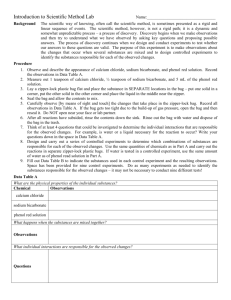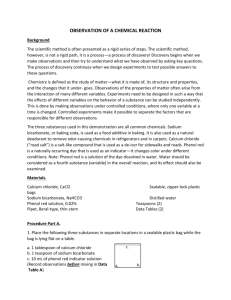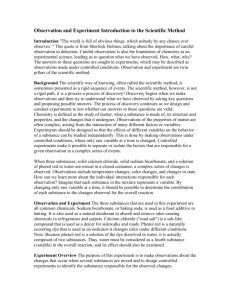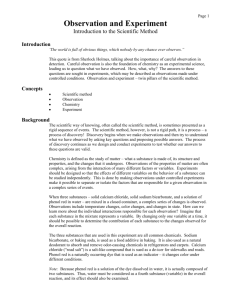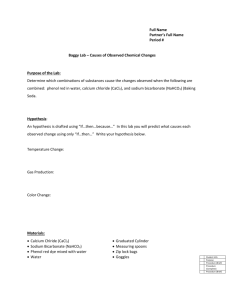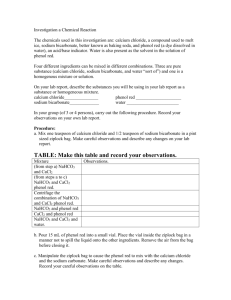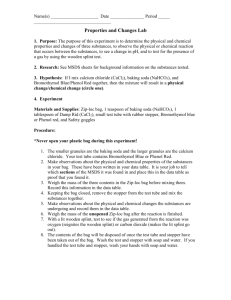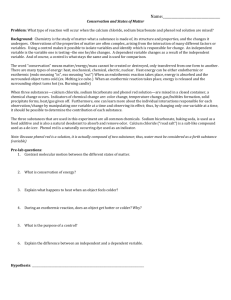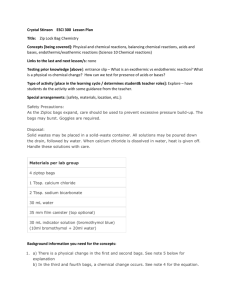Scientific Method: Chemistry Lab Experiment
advertisement
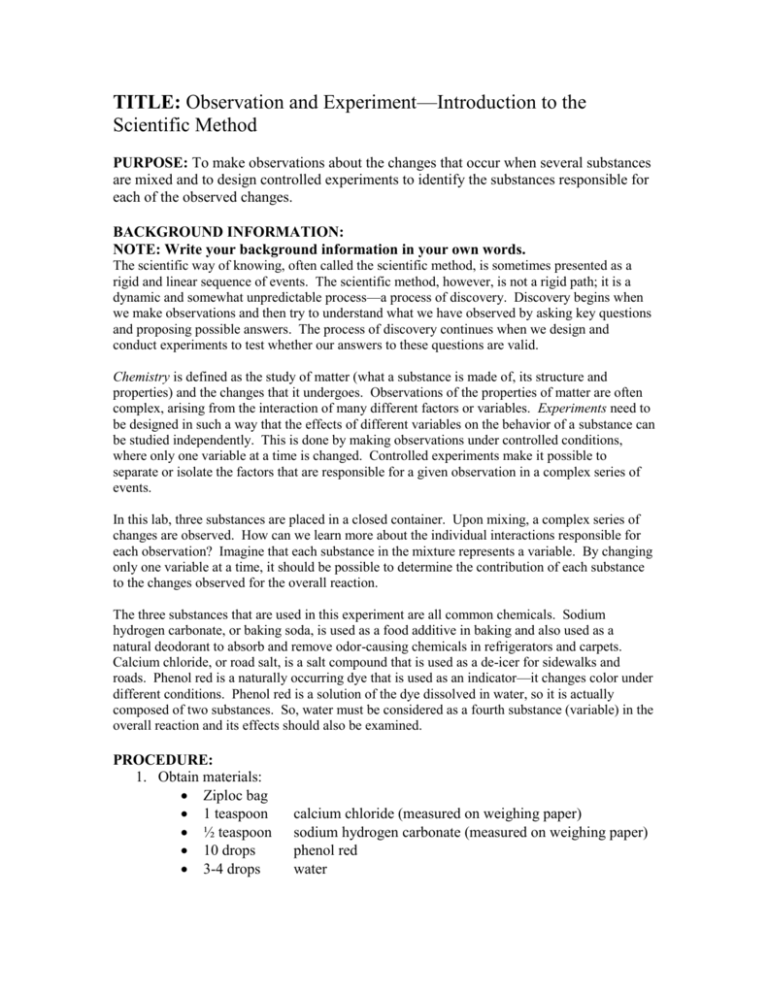
TITLE: Observation and Experiment—Introduction to the Scientific Method PURPOSE: To make observations about the changes that occur when several substances are mixed and to design controlled experiments to identify the substances responsible for each of the observed changes. BACKGROUND INFORMATION: NOTE: Write your background information in your own words. The scientific way of knowing, often called the scientific method, is sometimes presented as a rigid and linear sequence of events. The scientific method, however, is not a rigid path; it is a dynamic and somewhat unpredictable process—a process of discovery. Discovery begins when we make observations and then try to understand what we have observed by asking key questions and proposing possible answers. The process of discovery continues when we design and conduct experiments to test whether our answers to these questions are valid. Chemistry is defined as the study of matter (what a substance is made of, its structure and properties) and the changes that it undergoes. Observations of the properties of matter are often complex, arising from the interaction of many different factors or variables. Experiments need to be designed in such a way that the effects of different variables on the behavior of a substance can be studied independently. This is done by making observations under controlled conditions, where only one variable at a time is changed. Controlled experiments make it possible to separate or isolate the factors that are responsible for a given observation in a complex series of events. In this lab, three substances are placed in a closed container. Upon mixing, a complex series of changes are observed. How can we learn more about the individual interactions responsible for each observation? Imagine that each substance in the mixture represents a variable. By changing only one variable at a time, it should be possible to determine the contribution of each substance to the changes observed for the overall reaction. The three substances that are used in this experiment are all common chemicals. Sodium hydrogen carbonate, or baking soda, is used as a food additive in baking and also used as a natural deodorant to absorb and remove odor-causing chemicals in refrigerators and carpets. Calcium chloride, or road salt, is a salt compound that is used as a de-icer for sidewalks and roads. Phenol red is a naturally occurring dye that is used as an indicator—it changes color under different conditions. Phenol red is a solution of the dye dissolved in water, so it is actually composed of two substances. So, water must be considered as a fourth substance (variable) in the overall reaction and its effects should also be examined. PROCEDURE: 1. Obtain materials: Ziploc bag 1 teaspoon ½ teaspoon 10 drops 3-4 drops calcium chloride (measured on weighing paper) sodium hydrogen carbonate (measured on weighing paper) phenol red water 2. Observe and describe the appearance of calcium chloride, sodium hydrogen carbonate and phenol red solution. Record your observations in Data Table A. 3. Lay the Ziploc bag flat and place each of the substances in separate locations in the bag. 4. Squeeze out as much air as possible from the Ziploc bag and seal it. Allow the contents to mix thoroughly. 5. Carefully observe (by means of sight and touch) the changes that take place in the Ziploc bag. Record all observations in Data Table A. NOTE: If the bag gets too tight due to build-up of gas pressure, open the bag and then reseal it. DO NOT open the bag near your face or the face of anyone at your lab table. 6. After all the reactions have subsided, the contents of the bag can be rinsed down the drain under running water. Rinse out the bag with water and dry it with a paper towel. What questions arise concerning the changes that were observed in the bag? 7. Think of at least 4 questions that could be investigated to determine the individual interactions that are responsible for the observed changes. For example, is water or a liquid necessary for the reaction to occur? Write your questions down in the space provided in Data Table A. You must do this before you move on to step 8. 8. Design and carry out a series of control experiments to determine which combinations of substances are responsible for each of the observed changes. Use the same quantities of chemicals as in step #1 and carry out the reaction in a clean, dry Ziploc bags. If water is tested in a controlled experiment, use the same amount of water as phenol red from step #1. 9. Fill out Data Table B to indicate the substances used in each control experiment and the resulting observations. Space has been provided for nine control experiments. Do as many experiments as needed to identify the substances responsible for the observed changes—it may not be necessary to conduct nine different tests. 10. When you are convinced you have enough evidence to draw valid conclusions you should empty all Ziploc bags and rinse them with water and place in a way that they will dry for the next class. Wash your hands. DATA TABLE/ OBSERVATION Data Table A: The Overall Reaction What are the physical properties of the individual substance? Chemical Observations Calcium Chloride Sodium Bicarbonate Phenol Red Solution What happens when the substances are mixed together? Observations What individual interactions are responsible for the observed changes? Questions Data Table B. Control Experiments Number 1 2 3 4 5 6 7 8 9 Calcium Chloride Sodium Bicarbonate Phenol Red Water Observations DISCUSSION QUESTIONS Recommendation: Rewrite questions in lab book so that your answers are meaningful (because you will not be able to use this handout during the lab quiz). 1. Based on the results of the control experiments, what interaction among the substances seems to be responsible for the observed temperature change in the overall reaction? 2. Was there a temperature effect observed in any of the individual control experiments that was NOT observed in the overall reaction of the chemical substances? Explain. 3. What color change was observed in the overall reaction of the substance? Do the control experiments provide any evidence concerning the interaction(s) responsible for the observed color change? 4. Does the formation of gas bubbles occur independently of the observed temperature and color changes? Explain. 5. What control experiments were done to evaluate if a liquid is necessary for the observed effects in Part A? Does any reaction occur in the absence of water? 6. Is there any evidence that a new chemical substance is produced in the overall reaction of the three substances mixed in Part A? Explain. What interaction among the components must be responsible for the new substance? 7. Let’s assume that the chemical identity of calcium chloride is not changed when it is mixed with water. Suggest an experiment that could be done to prove or disprove this hypothesis, 8. Temperature changes are sometimes used as evidence to indicate that a chemical reaction, which produces a new chemical substance, has occurred. Comment on the suitability of this observation as a “test” of a chemical reaction.

